Russia’s Vladimir Putin has denied plans to attack Ukraine for months, but on Thursday he announced a “special military operation” in the Donbas region of the nation. Following the statement on live television, reports of explosions in Kyiv, Ukraine’s capital, and other regions of the country emerged.
Mr Putin’s latest moves came only days after ripping up a peace pact and ordering soldiers into two rebel-held eastern regions to “keep peace,” as he put it.
In recent months, Russia has placed at least 200,000 troops along Ukraine’s borders, raising worries that this is the start of a new invasion. What happens next might put Europe’s entire security system in jeopardy.
Where are Russian forces being dispatched, and why are they being dispatched?
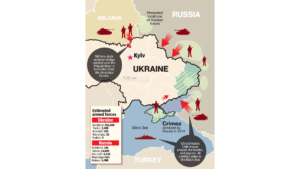
When Russia invaded Ukraine in 2014, pro-Putin separatists captured large swaths of the east and have been fighting Ukraine’s army ever since. Although an international peace agreement was signed in Minsk, the violence continues, and Russia’s president has announced that troops will be sent into two rebel-held districts. Russia’s usage of the term “peacekeepers” has been emphatically condemned by the UN Secretary-General.
The West believes Moscow is preparing a military invasion of Ukraine, a 44-million-strong country that shares borders with both Russia and the European Union. For starters, there have been rumours of tanks arriving in separatist-controlled Donetsk, and the most recent satellite photographs show Russian troops stationed near Ukraine’s borders.
President Putin warned Ukraine that if it did not stop the fighting in the east, it would be held responsible for more deaths. However, a succession of phoney incidents have already occurred, and any of them might be used as a pretext for a Russian strike.
What exactly is Putin’s issue with Ukraine?
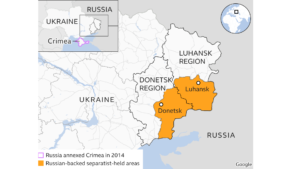
Russia has long opposed Ukraine’s accession to European institutions, including NATO and the European Union. Mr Putin has now argued that Ukraine is a puppet of the West and that it was never a real state in the first place.
He wants guarantees from the West and Ukraine that Ukraine would not join Nato, a 30-nation defensive alliance, and that it will demilitarise and become a neutral state.
Ukraine has extensive social and cultural ties with Russia, and Russian is widely spoken there, but those ties have deteriorated since Russia invaded Ukraine in 2014.
When Ukraine’s pro-Russian president was overthrown in early 2014, Russia launched an offensive. More than 14,000 people have died as a result of the battle in the east.
Why is it risky to label rebel areas?
Until recently, Russian proxies have ruled the so-called people’s republics of Donetsk and Luhansk.
Russian troops are for the first time recognised as stationed there, and they can even develop military bases, thanks to Mr Putin’s proclamation recognising them as autonomous.
The possibility of outright war increases dramatically when Russian forces are deployed to a region where hundreds of ceasefire violations occur every day. Under the Minsk peace accords, the two rebel enclaves would have had special status within Ukraine, but Mr Putin’s move prevents that.
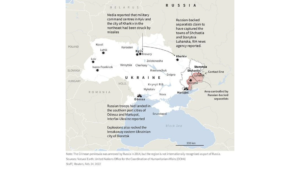
What makes the situation even more frightening is that the two rebel statelets are claiming all of Ukraine’s Donetsk and Luhansk regions, not simply the little territory they control. “We recognised them, didn’t we?” the Russian commander responded, “which means we recognised all of their founding papers.”
With baseless charges that Ukraine committed “genocide” in the east, Russia has already laid the groundwork for war. It has distributed over 700,000 passports in rebel-controlled areas, so any action might be justified as safeguarding its own residents.
How far is Russia willing to go?
President Putin may be content to rip up the eastern peace accords. He’s only mentioned “military-technical” measures in the past if he doesn’t get what he wants, and Moscow has already stated that “there is no Russian invasion.”
However, the chances of a diplomatic solution are slim, and the West is concerned that he will go even further. “We anticipate they will target Ukraine’s capital Kyiv, a city of 2.8 million innocent people,” said US Vice President Joe Biden.
Russian armies might theoretically rush over Ukraine from the east, north, and south, attempting to destabilise the country’s democratically elected government. They have the ability to mobilise troops in Crimea, Belarus, and along Ukraine’s eastern border.
https://twitter.com/DefenceHQ/status/1494315294382297091?ref_src=twsrc%5Etfw%7Ctwcamp%5Etweetembed%7Ctwterm%5E1494315294382297091%7Ctwgr%5E%7Ctwcon%5Es1_&ref_url=https%3A%2F%2Fwww.bbc.com%2Fnews%2Fworld-europe-56720589
However, Ukraine has recently strengthened its armed forces, and Russia would face a hostile populace. All reservists between the ages of 18 and 60 have been called up by the military.
Mark Milley, a top US military officer, warned the size of Russian forces would result in a “horrific” scenario including conflict in densely populated regions.
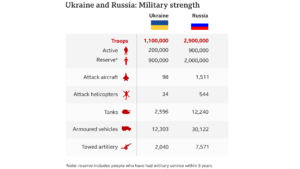
Other possibilities available to Russia’s commander include a no-fly zone, a blockade of Ukrainian ports, or the transfer of nuclear weapons to Belarus.
He’s also capable of launching cyber-attacks. Wednesday, the 23rd of February saw numerous Ukranian government websites succumbing to cyber attacks. In January, Ukrainian government websites were down, and in mid-February, two of the country’s largest banks were hacked.
What options does the West have?
Russia’s action is considered illegal by the West, and UN Secretary-General António Guterres has criticised it as a violation of Ukraine’s territorial integrity and sovereignty.
However, NATO allies have stated that no combat forces will be sent to Ukraine. Instead, they offered Ukraine consultants, weaponry, and field hospitals.
As a result, the primary response will be to impose sanctions on Russia.
- Germany has put a hold on its approval of Russia’s finished Nord Stream 2 gas pipeline, a substantial investment by both Russian and European firms.
- 351 MPs who endorsed Russia’s “illegal decision” to recognise rebel-held territories as separate states in parliament have been sanctioned by the EU.
- According to the US, Russia’s government is being shut off from Western financial institutions, and high-ranking “elites” are being targeted.
- Five major Russian banks and three billionaires are being targeted by the United Kingdom.
- Sanctions that are more severe are being held in reserve.
The US is scrutinising Russia’s financial institutions and key industries; the EU is concentrating on Russian access to financial markets; and the UK has warned that “those in and around the Kremlin will have nowhere to hide” as a result of restrictions on Russian companies’ access to the dollar and the pound.
Disconnecting Russia’s financial system from the international Swift payment system would be the ultimate economic blow. However, this could have a negative influence on the economy of the United States and Europe.
Meanwhile, NATO has deployed 5,000 troops to the Baltic republics and Poland. Romania, Bulgaria, Hungary, and Slovakia could each receive 4,000 more.
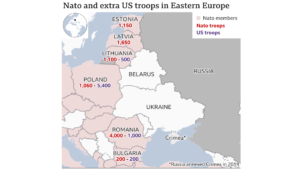
What is Putin’s goal?
In recasting its relationship with Nato, Russia has spoken of a “moment of truth” and highlighted three demands.
First and foremost, it seeks a legally enforceable assurance that Nato would not expand further. “It is an essential necessity for us to ensure that Ukraine never, ever joins NATO,” stated Deputy Foreign Minister Sergei Ryabkov.
Russia has “nowhere else to flee to – do they think we’ll just sit quietly by?” Mr Putin has said.
In 1994, Russia agreed to respect the independence and sovereignty of independent Ukraine.
However, President Putin authored a long paper last year identifying Russians and Ukrainians as “one nation,” and now he claims that Soviet Russia produced modern Ukraine altogether. He considers the Soviet Union’s demise in December 1991 to be the “disintegration of historical Russia.”
President Putin has also said that if Ukraine joins Nato, the alliance will attempt to reclaim Crimea.
His two main demands are that Nato not deploy “strike weapons near Russia’s borders” and that member states that joined the alliance after 1997 remove their forces and military facilities.
That includes Central and Eastern Europe, as well as the Baltic States. In reality, Russia wants Nato to re-establish its borders as they were prior to 1997.
What is NATO’s take on this?
Nato is a defensive alliance that welcomes new members with open arms, and its 30 members are determined that this will not change.
Ukraine’s president has called for “clear, reasonable timetables” for joining Nato, but as Germany’s chancellor has stated, this is unlikely to happen for a long time.
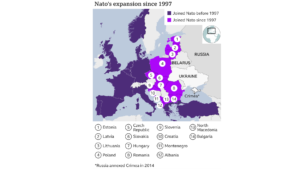
Any present Nato member countries giving up their membership is a non-starter.
According to President Putin, the West promised in 1990 that Nato would not expand “one inch to the east,” but did so nevertheless.
However, because this was before the Soviet Union’s demise, the pledge made to then-Soviet President Mikhail Gorbachev only applied to East Germany as part of a reunified Germany.
“The question of Nato enlargement was never considered” at the time, Mr Gorbachev later stated.
Is there any way out on the diplomatic front?
Apparently not for the time being, since planned meetings with Russia’s foreign minister have been cancelled by France and the United States. However, both France and Germany have stated that communication is possible.
Any final agreement would have to address both the eastern conflict and arms control.
The US had proposed to begin discussions on limiting short- and medium-range missiles as well as a new intercontinental missile accord. Russia demanded that all nuclear weapons from the United States be banned from entering their country.
A suggested “transparent mechanism” of mutual checks on missile stations – two in Russia and two in Romania and Poland – had received Russia’s approval.
Also read:





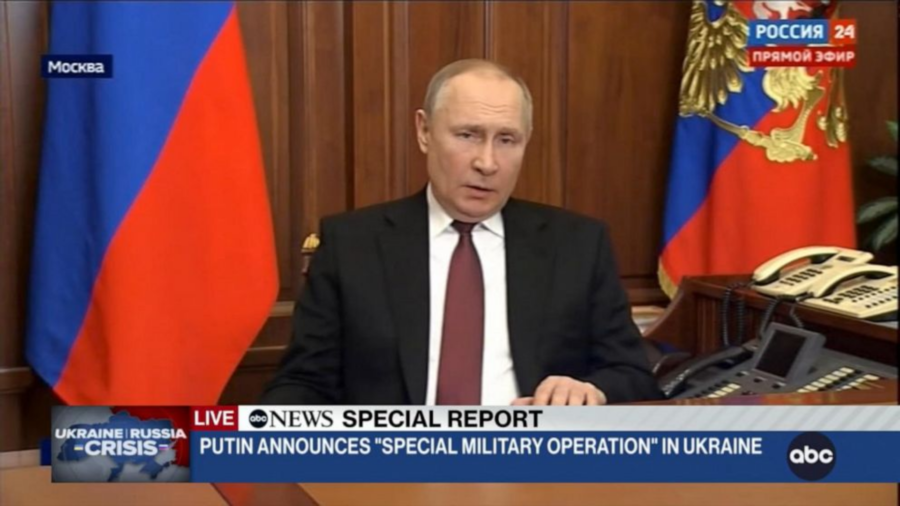

Add Comment